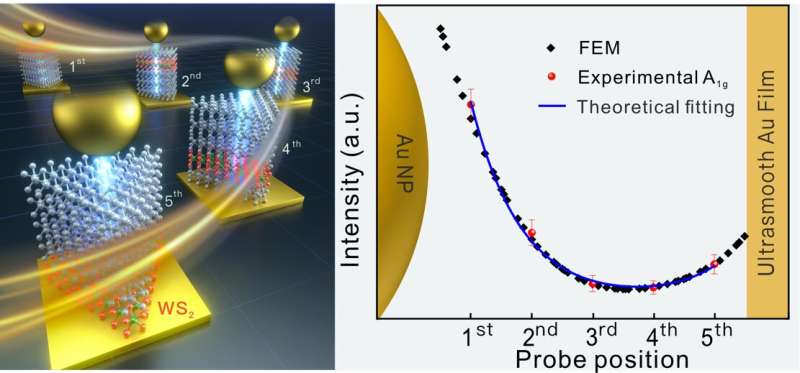Scientists observe longitudinal plasmonic field in nanocavity at subnano-scale

A group of scientists working on surface-enhanced Raman spectroscopy (SERS) has made a nanoruler to provide insight into the longitudinal plasmonic fields in nanocavities, according to research published in the Journal of the American Chemical Society.
SERS is a highly sensitive and powerful spectral analysis technique applicable in various fields. In contrast to weak Raman scattering, SERS achieves a dramatically enhanced Raman signal of up to 1010–15, allowing the analysis of single molecules.
"How we develop the technology depends, to a large extent, on what we know about plasmonic fields. In the experiments, we observed an uneven distribution in the plasmonic field at the nano-scale. But it lacks theoretic and experimental support. So we decided to figure it out," said Yang Liangbao, who leads the team at the Hefei Institutes of Physical Science of the Chinese Academy of Sciences.
"Powerful tools are needed," said Yang. At the beginning of the study, Yang and his team had to find some way to measure plasmonic field exploration. "So we designed and fabricated the nanoruler to look into it in high spatial resolution."
They made a unique nanoruler with a spatial resolution of about 7 x 10-10 m, which was actually a plasmonic nanocavity fabricated by combining ultra-smooth gold films and single gold nanoparticles.
In addition, they designed a special and innovative structure, the spacer layer, which is a five-layer two-dimensional atomic crystal, in which they inserted a monolayer of WS2 as a SERS probe and the remaining four layers of WS2 as reference layers.
This special design generated a strong enough quantitative SERS intensity, which was able to quantitatively and directly detect the longitudinal plasmonic field distribution.
In addition to the fabrication and direct experiments, the team supplemented and validated their research with theoretical derivations, calculations, and spectral measurements. Their results show that the longitudinal plasmonic field in an individual nanocavity is heterogeneously distributed with an unexpected large intensity gradient.
More information: Siyu Chen et al, Insight into the Heterogeneity of Longitudinal Plasmonic Field in a Nanocavity Using an Intercalated Two-Dimensional Atomic Crystal Probe with a ∼7 Å Resolution, Journal of the American Chemical Society (2022). DOI: 10.1021/jacs.2c03081
Journal information: Journal of the American Chemical Society
Provided by Chinese Academy of Sciences




















